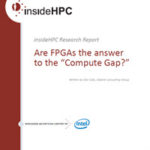“2017 will see the introduction of many technologies that will help shape the future of HPC systems. Production-scale ARM supercomputers, advancements in memory and storage technology such as DDN’s Infinite Memory Engine (IME), and much wider adoption of accelerator technologies and from Nvidia, Intel and FPGA manufacturers such as Xilinx and Altera, are all helping to define the supercomputers of tomorrow.”
Intel FPGAs Break Record for Deep Learning Facial Recognition
Today Intel announced record results on a new benchmark in deep learning and convolutional neural networks (CNN). ZTE’s engineers used Intel’s midrange Arria 10 FPGA for a cloud inferencing application using a CNN algorithm. “ZTE has achieved a new record – beyond a thousand images per second in facial recognition – with what is known as “theoretical high accuracy” achieved for their custom topology. Intel’s Arria 10 FPGA accelerated the raw design performance more than 10 times while maintaining the accuracy.”
insideHPC Research Report Are FPGAs the answer to the “Compute Gap?”
With the deluge of new data from new sources, it isn’t surprising to find that data centers are running short on compute capacity. In this research report, we explore the world of accelerators, primarily FPGAs, to see if they’re the right answer to fill
the ‘compute gap’.
Using Xeon + FPGA for Accelerating HPC Workloads
“The Exascale computing challenge is the current Holy Grail for high performance computing. It envisages building HPC systems capable of 10^18 floating point operations under a power input in the range of 20-40 MW. To achieve this feat, several barriers need to be overcome. These barriers or “walls” are not completely independent of each other, but present a lens through which HPC system design can be viewed as a whole, and its composing sub-systems optimized to overcome the persistent bottlenecks.”
Video: Altera’s Stratix 10 – 14nm FPGA Targeting 1GHz Performance
In this video from the 2015 Hot Chips Conference, Mike Hutton from Altera presents: Stratix 10 Altera’s 14nm FPGA Targeting 1GHz Performance. “Stratix 10 FPGAs and SoCs deliver breakthrough advantages in performance, power efficiency, density, and system integration: advantages that are unmatched in the industry. Featuring the revolutionary HyperFlex core fabric architecture and built on the Intel 14 nm Tri-Gate process, Stratix 10 devices deliver 2X core performance gains over previous-generation, high-performance FPGAs with up to 70% lower power.”
Intel Completes Altera Acquisition
Today Intel Corporation announced that it has completed the acquisition of Altera, a leading provider of field-programmable gate array (FPGA) technology. The acquisition complements Intel’s leading-edge product portfolio and enables new classes of products in the high-growth data center and Internet of Things (IoT) market segments.
Numascale Expands Performance and Features with NumaConnect-2
“At SC15, Numascale announced the availability of NumaConnect-2, a scalable cache coherent memory technology that connects servers in a single high performance shared memory image. The NumaConnect-2 advances the successful Numascale technology with a new parallel microarchitecture that results in a significantly higher interconnect bandwidth, outperforming its predecessor by a factor of up to 5x.”
Intel to Purchase Altera for $16.7 Billion
Intel announced plans to buy Altera, a maker of programmable logic semiconductors, for $16.7 billion, strengthening its presence in the datacenter market.
Radio Free HPC Looks at Recent Trends of Chipmaker Consolidation
In this episode, the Radio Free HPC team looks at some interesting industry developments from the past week. Samsung is reportedly looking at buying AMD, Intel may acquire Altera, and Micron has snapped up Convey Computer.









